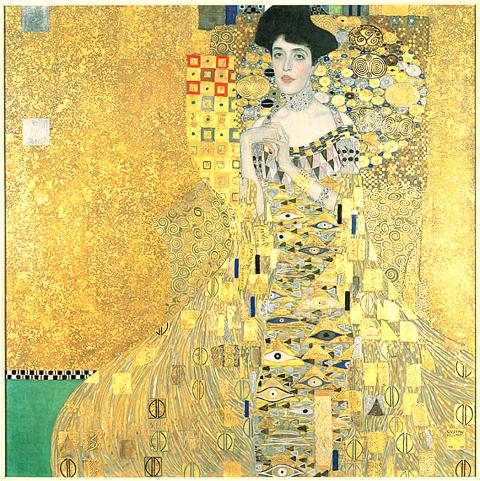His golden The Kiss adorns scarves and coffee mugs worldwide, while his portrait of Adele Bloch-Bauer sparked a decades-long restitution battle: this year, Austria celebrates the 150th anniversary of Klimt’s birth. Gustav Klimt, born on July 14, 1862, is one of the best known figures of the Jugendstil art period.
In honor of this milestone anniversary, Vienna’s biggest museums — led by the Belvedere, the Albertina and the Leopold Museum — are proposing no less than nine exhibits during the course of the year, all promising new insights into the artist’s life.
“More works by Gustav Klimt will be on display in Vienna in 2012 than ever before: from his decoration work in the Burgtheater and the Kunsthistorisches Museum to his largely unknown drawings and world-renowned paintings like The Kiss,” Vienna’s tourism board has already advertised.

Photo: Bloomberg
Klimt, the cofounder of the turn-of-the-century secession movement and one of Austria’s key modern artists alongside Egon Schiele and Oskar Kokoschka, was the second of seven children born to a gold engraver and his wife in Baumgarten, near Vienna.
Already as an art student, he founded an artists’ company with his brother Ernst and a friend, taking on major commissions to decorate luxurious salons and create theater sets. Although his work adorns the walls and ceilings of prestigious Viennese institutions like the Burgtheater and Kunsthistorisches Museum, Klimt is best known for his later golden period paintings.
One of them, the 1907 Portrait of Adele Bloch-Bauer I briefly became the most expensive painting ever sold when it changed hands in the US in 2006 for US$135 million. Earlier, it had made headlines due to a lengthy dispute between the Belvedere — home to the world’s largest collection of Klimt paintings, including The Kiss — and the family of the portrait’s previous Jewish owner, who said it had been stolen by the Nazis.
The Portrait of Adele Bloch-Bauer I was eventually handed back to the family after the Austrian state refused to buy it.
To celebrate Klimt’s 150th birthday, the Belvedere has planned an extraordinary exhibit, with its entire collection of Klimt paintings going on display from June 15 until January next year.
A separate exposition on the artist’s collaboration with architect Josef Hoffmann, another secession cofounder, is already running until March 4.
The Albertina will focus on Klimt’s drawings, while the Leopold museum is promising Gustav Klimt — Up Close and Personal, exploring his private life through his letters.
Further exhibits are planned in four more museums including the Wien Museum — the city’s history museum — and the Kunsthistorisches Museum, which will also offer special guided tours in the grand stairwell which Klimt worked on with his artists’ company. Moreover, his last workshop in a swanky Viennese district, now recreated, will open to the public in mid-2012, although the villa has been entirely remodeled on the exterior.
Klimt died on Feb. 6, 1918. His paintings recall a heyday in Viennese cultural life when the capital of the Austro-Hungarian empire bustled with the greatest artists and intellectuals of the day, from Sigmund Freud to Otto Wagner and and Adolf Loos.
The Vienna Ballet presented the first tribute of the year to Klimt on Sunday as dancers performed live among his works at the Belvedere during the traditional New Year’s Concert.

Taiwan Power Co (Taipower, 台電) and the New Taipei City Government in May last year agreed to allow the activation of a spent fuel storage facility for the Jinshan Nuclear Power Plant in Shihmen District (石門). The deal ended eleven years of legal wrangling. According to the Taipower announcement, the city government engaged in repeated delays, failing to approve water and soil conservation plans. Taipower said at the time that plans for another dry storage facility for the Guosheng Nuclear Power Plant in New Taipei City’s Wanli District (萬里) remained stuck in legal limbo. Later that year an agreement was reached

What does the Taiwan People’s Party (TPP) in the Huang Kuo-chang (黃國昌) era stand for? What sets it apart from their allies, the Chinese Nationalist Party (KMT)? With some shifts in tone and emphasis, the KMT’s stances have not changed significantly since the late 2000s and the era of former president Ma Ying-jeou (馬英九). The Democratic Progressive Party’s (DPP) current platform formed in the mid-2010s under the guidance of Tsai Ing-wen (蔡英文), and current President William Lai (賴清德) campaigned on continuity. Though their ideological stances may be a bit stale, they have the advantage of being broadly understood by the voters.

In a high-rise office building in Taipei’s government district, the primary agency for maintaining links to Thailand’s 108 Yunnan villages — which are home to a population of around 200,000 descendants of the Chinese Nationalist Party (KMT) armies stranded in Thailand following the Chinese Civil War — is the Overseas Community Affairs Council (OCAC). Established in China in 1926, the OCAC was born of a mandate to support Chinese education, culture and economic development in far flung Chinese diaspora communities, which, especially in southeast Asia, had underwritten the military insurgencies against the Qing Dynasty that led to the founding of

Artifacts found at archeological sites in France and Spain along the Bay of Biscay shoreline show that humans have been crafting tools from whale bones since more than 20,000 years ago, illustrating anew the resourcefulness of prehistoric people. The tools, primarily hunting implements such as projectile points, were fashioned from the bones of at least five species of large whales, the researchers said. Bones from sperm whales were the most abundant, followed by fin whales, gray whales, right or bowhead whales — two species indistinguishable with the analytical method used in the study — and blue whales. With seafaring capabilities by humans